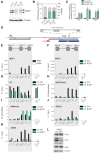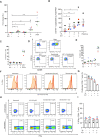Catchet-MS identifies IKZF1-targeting thalidomide analogues as novel HIV-1 latency reversal agents
- PMID: 35640596
- PMCID: PMC9177988
- DOI: 10.1093/nar/gkac407
Catchet-MS identifies IKZF1-targeting thalidomide analogues as novel HIV-1 latency reversal agents
Abstract
A major pharmacological strategy toward HIV cure aims to reverse latency in infected cells as a first step leading to their elimination. While the unbiased identification of molecular targets physically associated with the latent HIV-1 provirus would be highly valuable to unravel the molecular determinants of HIV-1 transcriptional repression and latency reversal, due to technical limitations, this has been challenging. Here we use a dCas9 targeted chromatin and histone enrichment strategy coupled to mass spectrometry (Catchet-MS) to probe the differential protein composition of the latent and activated HIV-1 5'LTR. Catchet-MS identified known and novel latent 5'LTR-associated host factors. Among these, IKZF1 is a novel HIV-1 transcriptional repressor, required for Polycomb Repressive Complex 2 recruitment to the LTR. We find the clinically advanced thalidomide analogue iberdomide, and the FDA approved analogues lenalidomide and pomalidomide, to be novel LRAs. We demonstrate that, by targeting IKZF1 for degradation, these compounds reverse HIV-1 latency in CD4+ T-cells isolated from virally suppressed people living with HIV-1 and that they are able to synergize with other known LRAs.
© The Author(s) 2022. Published by Oxford University Press on behalf of Nucleic Acids Research.
Figures






Similar articles
-
HibeRNAtion: HIV-1 RNA Metabolism and Viral Latency.Front Cell Infect Microbiol. 2022 Jun 14;12:855092. doi: 10.3389/fcimb.2022.855092. eCollection 2022. Front Cell Infect Microbiol. 2022. PMID: 35774399 Free PMC article. Review.
-
Targeting Ikaros and Aiolos with pomalidomide fails to reactivate or induce apoptosis of the latent HIV reservoir.J Virol. 2025 Mar 18;99(3):e0167624. doi: 10.1128/jvi.01676-24. Epub 2025 Feb 4. J Virol. 2025. PMID: 39902962 Free PMC article.
-
A Two-Color Haploid Genetic Screen Identifies Novel Host Factors Involved in HIV-1 Latency.mBio. 2021 Dec 21;12(6):e0298021. doi: 10.1128/mBio.02980-21. Epub 2021 Dec 7. mBio. 2021. PMID: 34872356 Free PMC article.
-
BRD9 functions as an HIV-1 latency regulatory factor.Proc Natl Acad Sci U S A. 2025 May 27;122(21):e2418467122. doi: 10.1073/pnas.2418467122. Epub 2025 May 22. Proc Natl Acad Sci U S A. 2025. PMID: 40402245
-
The sounds of silencing: dynamic epigenetic control of HIV latency.Curr Opin HIV AIDS. 2024 May 1;19(3):102-109. doi: 10.1097/COH.0000000000000850. Epub 2024 Mar 12. Curr Opin HIV AIDS. 2024. PMID: 38547337 Free PMC article. Review.
Cited by
-
PROTAC-mediated degradation of HIV-1 Nef efficiently restores cell-surface CD4 and MHC-I expression and blocks HIV-1 replication.Cell Chem Biol. 2024 Apr 18;31(4):658-668.e14. doi: 10.1016/j.chembiol.2024.02.004. Epub 2024 Mar 19. Cell Chem Biol. 2024. PMID: 38508197 Free PMC article.
-
HibeRNAtion: HIV-1 RNA Metabolism and Viral Latency.Front Cell Infect Microbiol. 2022 Jun 14;12:855092. doi: 10.3389/fcimb.2022.855092. eCollection 2022. Front Cell Infect Microbiol. 2022. PMID: 35774399 Free PMC article. Review.
-
PRMT3 reverses HIV-1 latency by increasing chromatin accessibility to form a TEAD4-P-TEFb-containing transcriptional hub.Nat Commun. 2025 May 15;16(1):4529. doi: 10.1038/s41467-025-59578-5. Nat Commun. 2025. PMID: 40374607 Free PMC article.
-
Targeting Ikaros and Aiolos with pomalidomide fails to reactivate or induce apoptosis of the latent HIV reservoir.J Virol. 2025 Mar 18;99(3):e0167624. doi: 10.1128/jvi.01676-24. Epub 2025 Feb 4. J Virol. 2025. PMID: 39902962 Free PMC article.
-
The BAF complex inhibitor pyrimethamine reverses HIV-1 latency in people with HIV-1 on antiretroviral therapy.Sci Adv. 2023 Mar 17;9(11):eade6675. doi: 10.1126/sciadv.ade6675. Epub 2023 Mar 15. Sci Adv. 2023. PMID: 36921041 Free PMC article. Clinical Trial.
References
-
- Siliciano J.M., Siliciano R.F.. The remarkable stability of the latent reservoir for HIV-1 in resting memory CD4+ T cells. J. Infect. Dis. 2015; 212:1345–1347. - PubMed
-
- Deeks S.G. HIV: shock and kill. Nature. 2012; 487:439–440. - PubMed
-
- Ne E., Palstra R.J., Mahmoudi T.. Transcription: insights from the HIV-1 promoter. Int. Rev. Cell Mol. Biol. 2018; 335:191–243. - PubMed
Publication types
MeSH terms
Substances
LinkOut - more resources
Full Text Sources
Medical
Molecular Biology Databases
Research Materials

